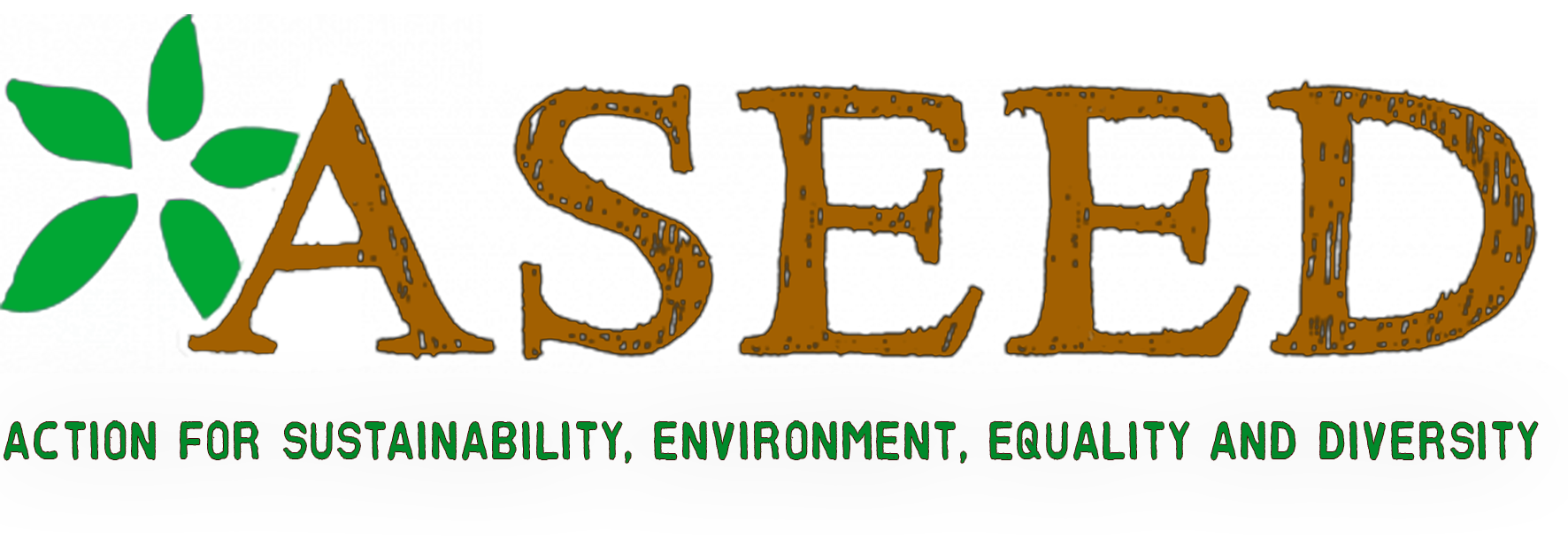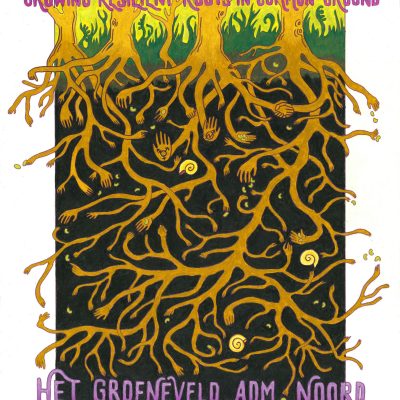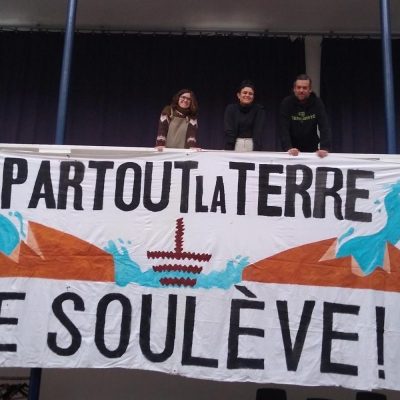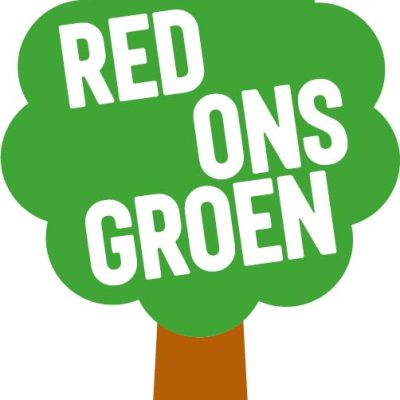At ASEED we have continuously concerned ourselves and been confronted with the topic of land – either through literature such as in the Reading Groups but also in what we saw happening around us, locally and on a global level. In September, in the Lutkemeerpolder we could witness agricultural land being subordinated to the interests of urban expansion and profit-making. The small-scale organic farm, the Boterbloem, had to give up most hectares of their land for it to be converted to concrete for a distribution center. This is a prime example of small-scale land artificialisation (see box below for explanation) and land grabbing (see explanation of the terms in the box below). The Lutkemeerpolder is not an isolated case: all over Europe farmland is sacrificed to make way for projects such as urban expansion, where agricultural land is often irreversibly transformed for non-agricultural purposes [1;2]. While this is a topic that certainly requires more attention, it is not the only land-related problem that is threatening the existence of small-scale farmers and making access to land increasingly difficult. Another issue, that is just as urgent and will be the focus of this article, is land concentration in Europe, whereby more and more agricultural land is concentrated into the hand of few farmers or corporations. As we will discuss, this has been directly influenced through the EU Communal Agricultural Policy (CAP) and the reform for 2023-2027 will not put an end to it.
Alarming Trends – High Prices and Land Only for the Few
At ASEED we hear it all around us, people who want to start farming close to Amsterdam and other places in the Netherlands struggle to get access to affordable arable land, and those who have successfully found land need to be lucky if they want to escape the high land rental prices. These experiences are in line with recent statistics by Eurostat, according to which land rental and land purchasing prices in the Netherlands were the highest of the entire EU in 2017 [5]. Skyrocketing land prices are not the only alarming trend and are only another consequence of land grabbing as well as land concentration. In fact, land in the EU is more unequally distributed than income [6] and today, while two-thirds of all farmers in the EU are small-scale farmers, cultivating less than 5ha, over half of all agricultural land is controlled by few very large industrial farms who make up only around 3% of all farmers [7]. In a competitive industrial farming environment, farming has become less and less viable for small-scale farmers and sometimes the only option for them seems to be to sell or lease their land either to investors who will transform it into a building ground or to other farmers who are then expanding their land share [1; 8]. Land grabbing is often implicated in the process of land concentration, as expanding farms are absorbing land from smaller farms as the example of Romania below illustrates. While the trend of land concentration, land grabbing, and rising land prices are a phenomenon affecting all EU member states, it is particularly worrisome for newer ones such as Hungary, Romania, and Bulgaria. Land prices there are still relatively cheap and therefore also attract foreign investors that purchase huge areas of land. Weak institutional protection in these countries as well as the desperate situation small farmers there find themselves in, make it especially easy for unfair land-grabbing deals to take place [8].
How the CAP Perpetuates Land Concentration
While two-thirds of all farms in the EU are small-scale farmers, they only control 11% of all farmland in the EU [10]. Between 2005 and 2016 the total number of farms in the EU has declined by almost 30% and the strongest decline could be witnessed amongst very small farms of below 2ha which have declined by almost 40% [5]. At the same time, large-scale industrial farms have increased by 18% in number [5] and are increasingly monopolizing the agricultural landscape and the market in Europe. This trend is worrying as small-scale farms play an important role in the cohesion of rural areas as they are providing jobs for people [11] and among other things safeguard cultural heritage [12].
Already for decades, the CAP has been criticized for encouraging the trend of land concentration and land grabbing by organizations such as La Via Campesina and arc2020. The following mechanisms in place are directly contributing to current land trends in the EU: Firstly, the ‘income support’ under Pillar I of the CAP is paid according to the size of the cultivated area of a farm which means the larger a farm is, the more money they receive. Consequently, already large farms accumulate more and more income which further strengthens their position in the market, and at the same time, farmers are incentivized to increase the size of their farms to capture more subsidies [8; 13]. This has lead to farm sizes increasing and land being increasingly concentrated [8].
Additionally, each EU member state also has to set eligibility criteria for who can receive direct payments which most often excludes small farmers below 1ha [13]. Initially, the post-2020 CAP proposal included a mandatory reduction of direct payments for those receiving above 60 000€/year, and while the parliament agreed with this, the council wants to make this voluntary for member states. But even if all member states would implement this, if they are allowed to deduct labor costs from the payment reductions (as proposed by the council and parliament) the redistributive payment will probably only have very little positive effect for small farmers [14].
Secondly, the CAP is also contributing to increasing farmland scarcity by not being strict enough in defining who can receive direct payments. If the CAP was truly a policy supporting only those who produce our food, only “genuine” farmers, those who are actively farming the land and cultivating food, should receive financial support through the CAP. However, currently, the conditions for who can receive payments do not make being productive on the land a requirement and so in some cases land is bought without being used for agriculture only to be able to claim the CAP subsidies [1]. This makes agricultural land even more difficult to access for new farmers and contributes to rising land prices [8,10]. While the proposal by the European Commission for the new CAP included a definition for ‘genuine farmer’, the council wants to make it voluntary for member states to define this.
The post-2020 CAP could have been an opportunity to redistribute land and income, put an end to a system which favours large scale farmers and support land accessibility for small-scale and new farmers. However, as the most recent positions of the council and parliament on the proposed CAP reform reveal, this is far from being true and so the CAP continues to be an accomplice to land concentration and land scarcity in the EU. Below is an overview of the measures that could have supported small-scale farmers (left, in green) and how the proposals by council and parliament correspond to this (right in red).

What Way Forward?
While the negotiations between the parliament and the council are still ongoing which gives hope that some of the measures will still be adjusted in favour of SFF, in any case, the area-based direct payments will remain. Thus, also the 2023-2027 CAP will continue to contribute to land concentration like the previous years. Confronted with this we are left to wonder if there other ways small farmers could be supported in their struggles and accessing land? Various organisations have already called for an EU Land Observatory to be established to monitor large-scale land deals and farm investments in the EU as well as endorsing the UN Voluntary Guidelines on the Responsible Governance of Tenure of Land, Fisheries and Forests and revising and changing policies accordingly. And if the EU would allow for it, member states could also restrict foreign investments in farmland which are a major contributor to farmland concentration [10]. But as with many policies and agreements we should not forget that while they do have a real life impact, processes are highly bureaucratic and effects can take years to show an impact. Therefore it is even more important that we show our support, in ways that go beyond ‘voting with our dollar’ and staying in the role of the consumer. Of course buying products from your local agroecological farmer can be one way to show support. But there are so many other roles we can take on, as activists, and as those who hold the belief that a socially and ecologically fair foodsystem depend on our ability to support small-scale farmers. In 2020 Nyéléni published a wonderful resource on “Grassroots Strategies to Preserve Farmland and Access to Land for Peasant Farming and Agroecology” [4] that demonstrate that action and resistance is happening all around us, every day and that small farmers, and peasants won’t be silenced. Over the past months also tens of thousands of farmers in India have striked and protested and while their main concern this time is not land concentration, they are also resisting policies that ignore the needs of the many small farmers in the country. In Europe, as well, resistance has been growing, but here, farmers make only a small percentage of the entire population, which is very different from India where 2/3 of the population depend on farming [15]. This is why it’s even more important that all of us show solidarity with small farmers and show that we won’t let unfair policies win over the strive for a diverse and locally thriving food-system.
ASEED is a small grassroots collective run mostly by volunteers. We are proud to have the ability to put time and energy into researching topics around agriculture, climate and social justice! However, in order to keep up structures that support this work, along with organizing events and direct actions we need structural funding. During this COVID crisis it is especially hard to find the kind of funding that pays for our financial administration, small budget for coordination and fundraising, and rent on our office. A great way to help us stay structurally funded is to become a monthly contributor! You can do that by visiting the SUPPORT US page on our website. Want to get involved in other ways? Contact us at info@aseed.net.
References
1: Kay, S., Peuch, J., Franco, J. (2015). Extent of farmland grabbing in the EU. Policy Department B: Structural and Cohesion Policies.
2: Cerrada-Serra, P., Colombo, L., Ortiz-Miranda, D., & Grando, S. (2018). Access to agricultural land in peri-urban spaces: social mobilisation and institutional frameworks in Rome and Valencia.
3: Hands on the Land. (2017) How do we define land grabbing? [link]
4: Nyéléni (2020). Your Land, my Land. [link]
5: Eurostat. (2019). Agriculture, forestry and fishery statistics.
6: TNI (2017). Land for the few. https://www.tni.org/en/publication/land-for-the-few-infographics
7: Eurostat (2018). Agriculture, forestry and fishery statistics.
8: Jan Douwe van der Ploeg, Jennifer C. Franco & Saturnino M. Borras Jr (2015) Land concentration and land grabbing in Europe: a preliminary analysis,
9:Bouniol, Judith (2013). Scramble for Land in Romania Jeopardizes Rural Territories Development. In Land Concentration, Land Grabbing and People’s Struggles in Europe. [link]
10: Kay, Silvia (2016). Land Grabbing and Land Concentration in Europe. Amsterdam TNI [link]
11: Davidova, S., & Bailey, A. (2014). Roles of Small and Semi‐subsistence Farms in the EU.
12: Kianicka, S., Knab, L., & Buchecker, M. (2010). Maiensäss–Swiss Alpine summer farms–an element of cultural heritage between conservation and further development: a qualitative case study.
13: European Commission (2019). Eligibility for direct payments of the Common Agricultural Policy. [link]
14: Jongeneel, R.A. (2018). Research for AGRI Committee – The CAP support beyond 2020: Assessing the future structure of direct payments and the rural developments interventions in the light of the EU agricultural and environmental challenges, European Parliament, Policy Department for Structural and Cohesion Policies. Brussels. [link]
15: Deutsche Welle. (Dec. 2020) [link]









